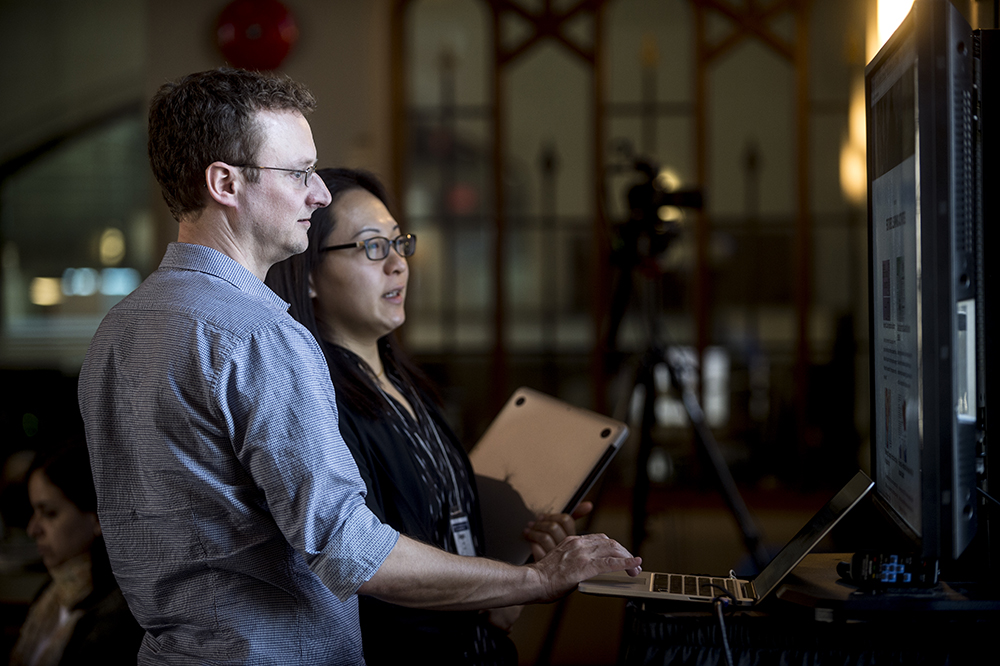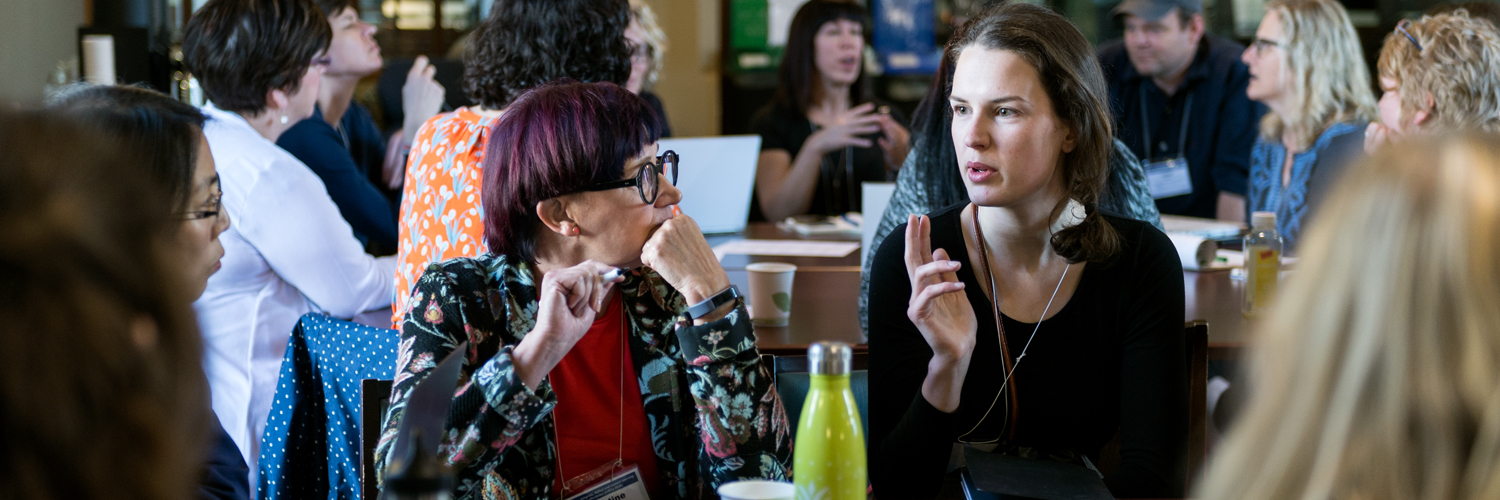The Faculty of Arts wants each of their students to cross the graduation stage with confidence — confidence in their skills, their future and the potential of their degree. But in a faculty with more than 12,000 students across 25 programs, this is no easy feat. In 2015, the Faculty received a Large Teaching and Learning Enhancement Fund (TLEF) grant to tackle this challenge. For the past few years, a dedicated team has been implementing a series of initiatives that is reimagining the undergraduate Arts experience and what an Arts education can be — the newly launched ubcarts.ca service enables Arts students to create their own everlasting portfolio.
The project
The team piloted two initiatives through their grant: a capacity-building workshop for faculty and staff and a pilot of ePortfolios for students.
To support student learning, the team developed the Signature Pedagogies workshop, designed to help faculty think deeply about their teaching and learning outcomes. Through looking at the skills students gain in their specific disciplines, faculty can help students better understand and articulate their learning.
“When the value of the discipline and the skills that go along with a practitioner in that discipline are made visible to students, they have a much deeper learning experience,” explains Julie Walchli, executive director of Work Integrated Education and Career Initiatives in the Faculty of Arts and project lead for the TLEF grant. “They can talk about that learning with other audiences, like their parents, friends, potential employers and on grad school applications.”
The second initiative was introducing ePortfolios in a selection of Arts courses.
ePortfolios are an online platform for students to curate and share work that represents their learning, skills and interests. They give students a space to self-reflect and chart their progress. Students can showcase academic and as activities from outside the classroom, such as co-op experiences or leadership roles.
“The value of a portfolio is it helps students create connections between their courses and their other experiences during their undergraduate degree,” Walchli said. “Students experience courses usually in a very siloed way. A portfolio lets them have work they’re doing in different contexts speak to each other through the structure of the portfolio.”

Participants in the CIRCLe 2018 symposium view e-portfolios Tuesday, May 1, 2018 during the Celebrate Learning Week conference at UBC. (Photo by Abigail Saxton)
The pilot
The team first piloted ePortfolios in three Geography courses. Students created ePortfolios through UBC Blogs, a weblogging platform that runs on WordPress. Depending on the course content and learning goals, instructors incorporated the ePortfolios in different ways.
In GEOG 270, for example, students uploaded lab assignments to their ePortfolio, along with descriptions of their work and what they learned. In GEOG 379B, students used their ePortfolios to submit assignments, reflections and commented on their peers’ work.
The ePortfolios received mixed feedback. For some students, it felt like extra work, and they were still unsure about the benefits. After feedback from the first year, the team created an orientation video that explains why ePortfolios matter, and student testimonial videos where students shared their perspectives on ePortfolios.
Navigating online spaces
The team expanded the pilot to more courses, including Visual Arts, Philosophy, and First Nations and Indigenous Studies (FNIS). David Gaertner, an instructor in FNIS, implemented ePortfolios in two of his courses.
In FNIS 100, students selected a topic related to Indigenous studies within their field of interest. Their ePortfolio consisted of a series of steps in the project leading to a final research paper. In FNIS 454, students wrote blog posts and showcased their work towards developing information communication technology prototypes, including digital maps, sound installations, YouTube videos and websites for UBC’s new Indian Residential School History and Dialogue Centre.
While many of Gaertner’s students were familiar with blogs, few had shared their academic work in public forums.
“They don’t know how to use the tools they’ve learned in academia and translate that in a way they think is going to resonate with their friends or family or with a wider academic public,” Gaertner said.
ePortfolios were a useful way to get his students to think outside of academic writing.
“[It] helped them think differently about audience and what it meant to write in Indigenous Studies for people beyond their peers and their professor.”
But with any work published online, there is also the risk of criticism. Conversations began arising about what work students wanted to share publicly versus privately.
“If you’re writing about Indigenous studies, and particularly if you are an Indigenous person or a woman, a person of colour, a differently abled person — those people take a lot of flak online,” he said. “That’s something I try to prepare [my students] for as well, and I let them know that if it does happen…it’s something they don’t have to keep to themselves. We can talk about it in class.”
The impact
Christa Yeung, a fourth-year Geography student, first developed her ePortfolio in GEOG 270, one of the first courses that piloted ePortfolios. For Yeung, developing her ePortfolio was a way to showcase the full range of her learning.
“Your school experience shouldn’t be narrowed down to just academic work,” she said. “[ePortfolios are] another way to express the breadth of your academic experience.”
One of Yeung’s top considerations when creating her ePortfolio was her audience.
“I wrote it to the audience of an employer because I wanted to do a co-op term in [geographic information systems], which did happen later. So it was really helpful,” she said.
The effort Yeung put into her ePortfolio was evident. She went on to receive the 2016/17 Arts ePortfolio Student of the Year Award, which was developed to recognize and share the high quality ePortfolios students were creating.
Through working on her ePortfolio, Yeung has become more aware of the importance of her work.
“Your work extends outside of the classroom and the university and into the community and society,” Yeung said. “Your work matters, so try to show it no matter what.”
Gaertner similarly hopes ePortfolios will encourage students to share their ideas with each other, and with the wider community.
“I think it’s more and more vital that students are getting their ideas and what they’re thinking about out there,” he said. “We need, maybe now more than ever, students who are doing that kind of critical thinking in public, online spaces.”
The Web Space
In their final year of project funding, the team looked into expanding ePortfolios to more students — namely, all 12,000 students in the Faculty of Arts.
While the majority of the pilot courses used UBC Blogs, the team decided to move forward with a custom WordPress ePortfolio theme, developed by Arts ISIT, so as to have additional options for flexibility in the design, layout, navigation, and sharing of student ePortfolios. Known as the UBC Arts Student Web Space, Arts students will be able to use this platform to create an ePortfolio with information about their personal and academic development.
One unique feature of the Arts Student Web Space is the custom blocks, where learning activities can sit in special collections.
Fred Cutler, former director of Arts ISIT, explains, “If a student does a project in a course, or has a volunteer experience, or even a personal travel experience, it might be relevant to present that activity or that experience bundled with other ones for a particular audience or with a given theme.”
Cutler hopes students will see this new tool as an opportunity to archive and reflect on their experiences.
“We don’t want students to get the impression this is just another way to submit work for assignments,” Cutler said. “We want to use a tool like this to change programs’ and instructors’ and students’ culture around keeping student work and making that work presentable beyond the curricular setting.”
What’s next
In September 2018, all Arts students will have access to the Student Web Space. As the Web Space launches, the next step will be introducing the platform and the benefits of ePortfolios to students. The team is continuing to look at ways to integrate ePortfolios into the curriculum and making it a key piece of Arts education.
Though the team is in their third and final year of grant funding, they say this is just the beginning.
“[The TLEF is] seeding things that are going to carry on after the grant ends,” Walchli said. “I think the grant has given us a chance to play with some concepts that were out there and really think about how they might work for Arts students and faculty members.”
References and resources
- Project partners: Arts Instructional Support and Information Technology; Centre for Student Involvement & Careers; Centre for Teaching, Learning and Technology; and Office of the Vice-President, Students
- TLEF Showcase posters: tlef.ubc.ca/funded-proposals/entry/5/
- Faculty of Arts ePortfolio Resources for Students: eportfolios.arts.ubc.ca/
- Arts ISIT Resources for Faculty: isit.arts.ubc.ca/eportfolios/
- Archive of Capture, Integrate, Reflect and Connect Learning with ePortfolios (CIRCLe 2018) symposium at UBC: circle2018.arts.ubc.ca/
- The Conference Board of Canada. (2018). Getting to work: Career skills development for social sciences and humanities graduates. conferenceboard.ca/e-library/abstract.aspx?did=9463
- Catalyst for Learning: ePortfolio Resources & Research: c2l.mcnrc.org/
For further information about this project, please contact Julie Walchli: julie.walchli@ubc.ca.
